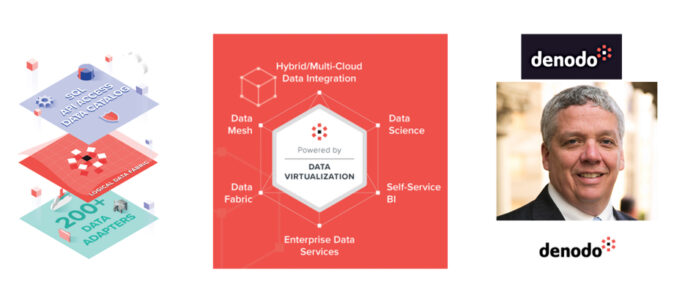Interview: Denodo claims its DeepQuery facility enables generative AI to go beyond retrieval-augmented generation (RAG), which just retrieves facts. DeepQuery investigates, synthesizes, and explains its reasoning. Denodo says DeepQuery will let users ask questions such as “What’s driving changes in customer retention across regions?” and respond by connecting to live, governed data across different systems, apply expert-level reasoning, and deliver answers in minutes.
The company produces a data management platform product that virtualizes data sources, providing real-time access to relational databases, cloud databases, NoSQL databases, OLAP databases, enterprise apps like SAP, big data, SaaS apps, streaming data, unstructured data, Excel files, CSV data, and more. DeepQuery uses this middleware platform and answers, it says, multi-step analytical questions.
We spoke to Denodo’s Director of Product Marketing, Kevin Bohan, to find out more.
Blocks & Files: What are the limitations of standard GenAI tools in data analysis?

Kevin Bohan: Standard GenAI tools can tell you what happened, but are lacking at telling you why. Standard GenAI tools typically retrieve facts and answer straightforward questions by summarizing information and data gathered from indexed content, and they rarely expose a transparent reasoning path you can fully trust. They lack the reasoning power to uncover drivers or root causes behind trends or patterns. This means that when enterprises are interrogating their data, they’re left with surface-level insights they can’t confidently act on.
Standard GenAI tools are typically limited to answering questions like “What’s our churn rate in the Northeast?”, where the response will be an isolated figure.
DeepQuery goes a step further, offering an explainable, reasoning-driven analysis capability via natural language processing. It allows users to ask complex questions like “Why is churn increasing in the Northeast, and what factors – customer behavior, service response time, or competitive activity – are contributing?” and receive reliable responses at speed. This provides a level of competitive intelligence which was previously inaccessible and opens up data insights for a far greater portion of the workforce.
Blocks & Files: What are multi-step analytical questions?
Kevin Bohan: Multi-step analytical questions require breaking down complex inquiries into smaller parts, accessing multiple data sources and synthesising insights to explain patterns or root causes. DeepQuery handles these by reasoning across live, governed data to deliver structured answers that traditional GenAI tools can’t easily produce.
Blocks & Files: Should indexed content be replaced or augmented?
Kevin Bohan: Indexed content should be augmented instead of being replaced. DeepQuery builds on existing indexed data by applying structured reasoning across live, governed sources. This produces richer, explainable insights without discarding the speed and utility of traditional GenAI.
Blocks & Files: What is structured reasoning?
Kevin Bohan: Structured reasoning is the process of breaking down complex questions into smaller, logical components while analysing data across multiple sources to create explainable and logical insights. DeepQuery uses this approach to answer questions like “Why did fund outflows spike last quarter?”. Instead of isolated facts, it provides transparent, multi-step conclusions with citations. This helps users understand not just what happened – but why, enabling faster, more confident decision-making. It turns opaque “LLM guesses” into explainable analytics you can audit, and trust.
Blocks & Files: How does DeepQuery apply structured reasoning across live, governed
data?
Kevin Bohan: DeepQuery runs on the Denodo platform’s semantic layer, so it can operate directly on live enterprise systems without replication or new pipelines.
DeepQuery applies structured reasoning by simplifying complex questions into searchable components, accessing live, governed data across systems and synthesising insights with logic and citations. This allows explainable, cross-functional analysis in real time, helping users understand not just what happened, but why – all without creating data copies.
Blocks & Files: Who are the users Denodo has in mind for DeepQuery?
Kevin Bohan: DeepQuery is designed for business users, analysts and non-technical teams who need fast, explainable insights from complex, cross-functional data. Its sector-agnostic architecture allows users across industries to ask open-ended questions in natural language, without needing technical expertise. This makes data analysis much more accessible to a wider audience, reduces reliance on data specialists and empowers teams to investigate root causes of trends.
Blocks & Files: What benefits will they get that they can’t get now?
Kevin Bohan: The single biggest benefit is confidence. DeepQuery gives users more swift, explainable, evidence-backed answers to complex questions like “What’s driving changes in customer retention across regions?”. This means that teams can move from reactive reporting to proactive, insight-driven decision making.
Comment
Our understanding is that DeepQuery integrates with third-party LLM services, such as OpenAI or Amazon Bedrock, via REST APIs to generate responses. What happens is that DeepQuery receives a user’s natural language question and interprets it using the LLM set up by the Denodo admin. It maps the natural language input to the relevant structured data sources using its metadata catalog. DeepQuery combines the LLM’s ability to interpret the query with its own query optimization engine, which understands the schema and relationships in the data.
The LLM can provide capabilities to refine the query, handle ambiguities, and infer relationships or context not explicitly stated in the question. So, if a user says, “Show me sales trends for last quarter,” the LLM can infer the need for time-series data and specific metrics, while Denodo maps this to the appropriate data fields.
In effect it translates the user’s natural language query into structured queries (e.g., SQL) that can be executed against the underlying data sources. Denodo retrieves the results, and sends them back to the LLM for natural language response generation, which can include a summary and a detailed explanation.








